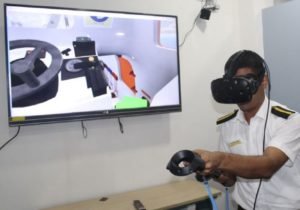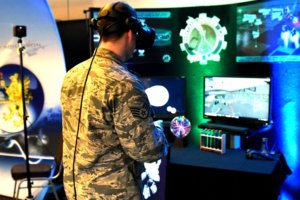Welcome to our recurring post, 3D Interactive Tech Talk, highlighting how interactive technology is being used right now and where it’s headed.
Mariners Adopting Simulation Training to Replace ‘Simulators’
 Simulators have become fairly standard training tools in the maritime industry, but they’re expensive and immobile – and did we say expensive? It’s a lot to invest in, particularly as periodic upgrades to the equipment keep pace with changing technology prove pretty cost prohibitive as well.
Simulators have become fairly standard training tools in the maritime industry, but they’re expensive and immobile – and did we say expensive? It’s a lot to invest in, particularly as periodic upgrades to the equipment keep pace with changing technology prove pretty cost prohibitive as well.
This is changing at Anglo-Eastern Maritime Academy in Karjat in India, where its ship manager training has adopted VR/AR as part of the comprehensive training on offer to its 440 cadets.
With VR and AR training, learning is much more portable, requiring either a tablet or headset and, if using headsets, a specific room size. There are associated startup costs, of course, but not only is the technology easier to adapt, it allows seafarers to physically practice and learn “tasks where risk would be involved in real life.”
Sheppard Air Force Base Exploring VR Training Options
 Sheppard Air Force Base is the largest technical training base in the 2nd Air Force, responsible for training 60,000 airmen on more than 600 courses each year, and they’ve begun to explore incorporating augmented and virtual reality capabilities into their processes.
Sheppard Air Force Base is the largest technical training base in the 2nd Air Force, responsible for training 60,000 airmen on more than 600 courses each year, and they’ve begun to explore incorporating augmented and virtual reality capabilities into their processes.
“The technology has finally caught up with our imaginations. I really look for a large part of our training to be done this way from now on.”
It makes sense. They’ve realized the benefits simulations offer – not just saving wear and tear on expensive equipment, but allowing students “to learn in a different way, to see and understand things in ways not possible from book reading or two-dimensional graphics.”
Using VR goggles, cadets can work on programs together or independently and then review (with an instructor) what they did right and wrong – and then “flip a switch and start it again” drastically improving time it takes to train new technicians.
“The long-term goal is to reduce training time by a third or even half. . . . and [in] the future, they could possibly build 20 years of experience into a maintainer in a matter of months.”
The most challenging part right now is deciding which courses to prioritize.
Do you have a question regarding this technology? Hit us up here now to discuss how this could apply to your needs.
And check out our virtual training solutions to see 6 real world case studies on how businesses are training their operations, maintenance, and field service teams.


